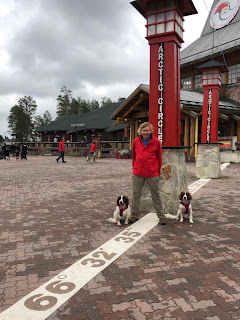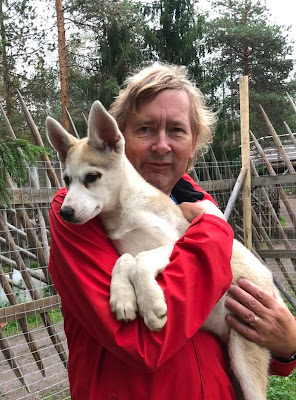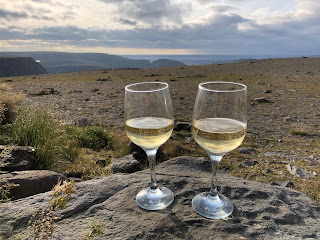Cute heh? Who could resist the chance to see Huskies up close! After a few days on the road, today we were in Rovaniemi, the capital of Lapland, and it was time to kick back and do some tourist stuff. We visited an excellent museum, went to Santa's village, cuddled some Huskies, and ate out for the first time since Stockholm.
 We'd spent the night in one of the great little lakeside rest areas with wooden Laavu (Sami shelters) fire pits and composting toilets. The latter are useful for emptying our (chemical free) toilet cassette, but not much else. This morning we took the spaniels for a walk in the woods, where they were keen to explore smells of reindeer. Then it was on the road for the journey to Rovaniemi so that we could be at the Husky park in good time for the midday tour.
We'd spent the night in one of the great little lakeside rest areas with wooden Laavu (Sami shelters) fire pits and composting toilets. The latter are useful for emptying our (chemical free) toilet cassette, but not much else. This morning we took the spaniels for a walk in the woods, where they were keen to explore smells of reindeer. Then it was on the road for the journey to Rovaniemi so that we could be at the Husky park in good time for the midday tour.The Husky Park was at Santa's Village, a year round attraction that lacks something with no snow on the ground, but was nevertheless nicely done, and not too tacky. To our delight we were told that, after the talk and tour of the Husky area, we would be invited to be guinea pigs for the new "Hug a Husky" area that was due to open tomorrow. So we skipped the €30 per person fee, and got in there with this year's puppies.
 No one had told the puppies that they were there to be hugged, and socialisation was in its very early stages, so the first challenge was to catch your puppy. They were highly delighted to be out of their pens, and their immediate priority was to run in dizzy circles with their littermates. Years of catching Jackson Spaniel when he was on one of his jaunts had taught me some skills, and I soon had one in my arms, where my ears were given a good wash.
No one had told the puppies that they were there to be hugged, and socialisation was in its very early stages, so the first challenge was to catch your puppy. They were highly delighted to be out of their pens, and their immediate priority was to run in dizzy circles with their littermates. Years of catching Jackson Spaniel when he was on one of his jaunts had taught me some skills, and I soon had one in my arms, where my ears were given a good wash. We could have stayed there all day chatting to the mushers and playing with the puppies and their mums, but we had our own pups to get back to, and to take for a walk around Santa's village. On our way we sadly stepped back across the Arctic Circle. Max wasn't keen, being a heavy coated sort of dog, but Elsa was ready to start moving south. It seems an age since we crossed the line northbound on a ferry off Norway. In fact it was the 7th August, only three and a half weeks ago, but so much has happened since then.
 |
| Max above the Arctic Circle, Elsa below |
After an entertaining wander around the village, we were lured into a café, where the prospect of our first meal out since Sweden was too much for us, and we both tucked into a burger and fries. Being where we were it was probably almost as expensive as Norway, but it hit the spot after five weeks of healthy, home-cooked food.
A quick top-up with water and fuel at the Shell garage across the road, and it was back into Rovaniemi itself for the Arktikum, a museum of the Arctic. This proved to be an excellent centre of science, ethnography, natural history and art, and we could have spent a couple of days there. As it was, our brains were overloaded after a couple of hours, and we skimmed a couple of galleries, promising ourselves to do more research later.
 |
| The Arktikum Museum |
 |
| First catch your husky |
 |
| Got one! |



















































